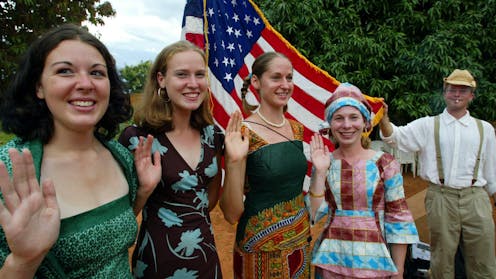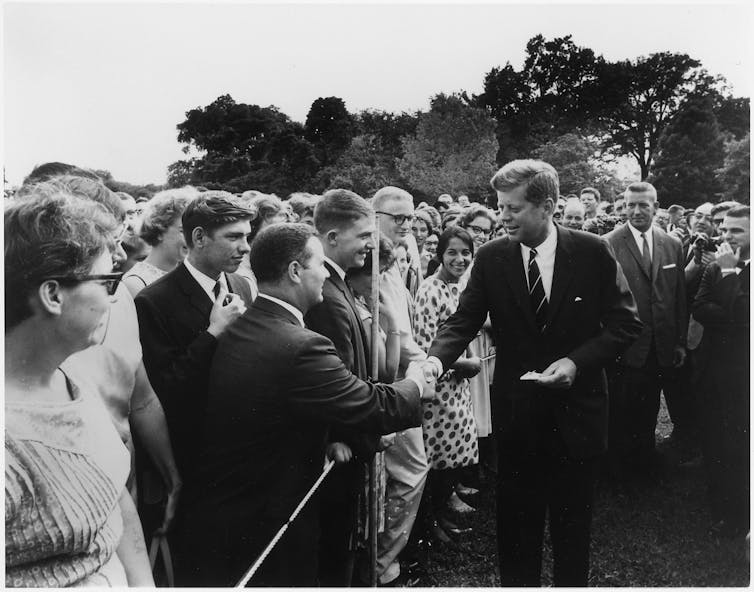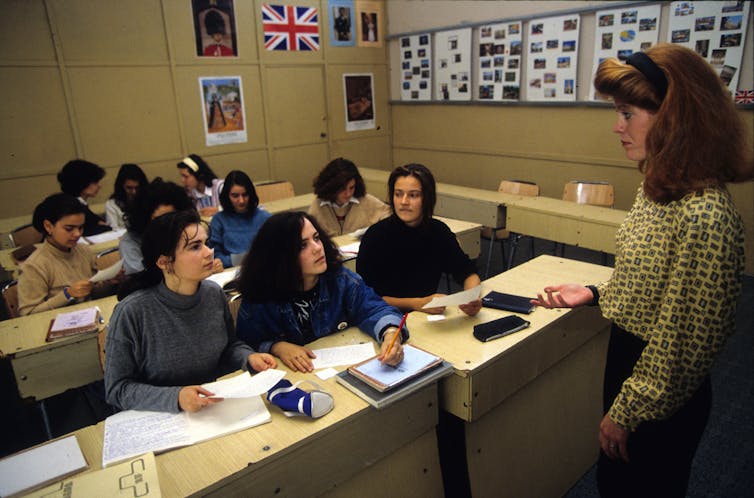Peace Corps isn’t just about helping others − it’s a key part of US public diplomacy
- Written by Thomas J Nisley, Professor of Government and International Affairs, Kennesaw State University
 Peace Corps volunteers pose with the U.S. flag after they are sworn in during a 2002 event in Burkina Faso. Issouf Sanogo/AFP via Getty Images
Peace Corps volunteers pose with the U.S. flag after they are sworn in during a 2002 event in Burkina Faso. Issouf Sanogo/AFP via Getty Images Since President Donald Trump returned to the White House in January 2025, his administration has slashed the work of many U.S. government agencies, including those focused on foreign policy. Now, there is concern that the Peace Corps could join the other foreign aid programs the administration is trying to dismantle.
The United States Agency for International Development largely shut down in February and March 2025, with its workforce reduced from more than 10,000 to 15 people on staff.
In early April 2025, members of Elon Musk’s Department of Government Efficiency showed up at Peace Corps headquarters in Washington, D.C., signaling possible cuts.
DOGE has also called for reducing the number of the Peace Corps’970 full-time staff who help recruit and oversee the work of volunteers.
The Guardian reported on April 28 that the Peace Corps is offering staff a buyout, and that Peace Corps leadership expects “significant restructuring efforts.”
The Peace Corps told The New York Times in an April 28 statement that “the agency will remain operational and continue to recruit, place, and train volunteers, while continuing to support their health, safety and security, and effective service.”
As a scholar of international affairs, I think it is important to understand the subtle – but important – role that the Peace Corps plays in helping the U.S. maintain a positive international image.
 President John F. Kennedy greets Peace Corps volunteers at the White House in August 1962.Smith Collection/Gado/Getty Images
President John F. Kennedy greets Peace Corps volunteers at the White House in August 1962.Smith Collection/Gado/Getty ImagesUnderstanding the Peace Corps
In 1961, President John F. Kennedy created the Peace Corps, an independent agency in the federal government, alongside USAID as a way to reinvigorate American diplomacy.
Kennedy viewed the State Department as an organization that lacked innovation, staffed by self-serving people without much practical experience.
Since the 1960s, the Peace Corps has sent more than 240,000 U.S. citizens – many of them young people – to work as volunteers in more than 60 low- and middle-income countries on short-term projects, ranging from teaching students English to helping farmers increase their food production. This works out to about 3,500 to 4,000 volunteers abroad each year.
As Kennedy hoped, many of these American volunteers returned home to eventually serve in the State Department, with some rising to the top ranks, such as Christopher Hill, a career diplomat who served in the Peace Corps in Cameroon in the 1970s.
Peace Corps volunteers, sometimes known as PCVs, also go on to work in other types of public service, including in educational roles. It has also been common for former Peace Corps volunteers to work for USAID.
Peace Corps’ role in US government
The Peace Corps is not part of the day-to-day activities of U.S. foreign policy in the same way as the State Department, for example, which has diplomatic missions across the world.
The Peace Corps, with a US$495 million annual budget, does contribute to U.S. foreign policy goals by enhancing U.S. soft power. Soft power, in this context, means getting others to want what you want.
The political scientist Joseph Nye introduced the academic concept of soft power to the mainstream in the early 1990s. It is often misunderstood. Some mistakenly refer to the military as hard power, and economic and diplomatic tools as soft power.
But soft power – and the allure of a project like the Peace Corps – is founded in the power of attraction. The Peace Corps, simply put, helps improve the U.S.’s image worldwide.
My research on Latin American countries has shown that the presence of a Peace Corps program improves the popular perception of the U.S. among communities there. A good reputation fosters goodwill and helps the U.S. achieve its concrete foreign policy goals, be it making a trade deal or helping to end a conflict.
The political scientist Stephen Magu has found similar results across Africa, including a connection between the number of Peace Corps volunteers in a country and support for the U.S. in its work at the United Nations.
The Peace Corps’ experience
The Peace Corps uses a very selective application process to recruit Americans of all ages to volunteer for two years in a foreign country, doing different kinds of service work ranging from agriculture and education to health and the environment.
Most are younger people with college degrees, but there is no upper age limit to qualify and no requirement of a college degree to serve.
There is no single Peace Corps experience.
But all volunteers live and work in a community that has requested a volunteer to help with different types of activities. This could include helping local women set up their own small businesses in Panama or offering health workshops on reducing the risk of contracting and spreading HIV in Eswatini, formerly knwon as Swaziland. These volunteers are usually *the only Americans for miles around.
Volunteers are expected to live modestly and are paid a monthly living allowance that covers their bare necessities.
Volunteers’ work is not easy and not without risk. Since 1961, 311 people have died while serving. Most of the deaths are due to accidents, usually related to transportation. Some have died from diseases and illness, and a few have been victims of murder.
Peace Corps’ approach to volunteer work
The Peace Corps emphasizes what is known as grassroots development in foreign aid circles. This means that a Peace Corps volunteer tries to use local money and expertise to achieve goals jointly identified by the community and the volunteer.
Critics of the Peace Corpshave argued, among other things, that it has not made widespread changes that reliably last beyond the two-year term of each volunteer.
But the Peace Corps is not intended to change the trajectory of a country’s economic development and suddenly make a poor country a rich one. Volunteers do help the people in the community they serve in small but meaningful ways.
In my own service as a Peace Corps volunteer in the Dominican Republic from 1989 to 1991, for example, I had a demonstration vegetable garden where I grew nutritious vegetables such as spinach and mustard greens. Dominicans did not traditionally eat these vegetables, but I got my neighbors and friends to try them. Some learned to really like them and began to grow them on their own.
 A Peace Corps volunteer teaches English to students in Bucharest, Romania, in the 1990s.Paul Conklin/Getty Images
A Peace Corps volunteer teaches English to students in Bucharest, Romania, in the 1990s.Paul Conklin/Getty ImagesAnother kind of public diplomacy
When asked in 1962 how he saw the relationship of the Peace Corps to U.S. foreign policy, Kennedy responded that he saw the Peace Corps as “an opportunity to emphasize a different part of our American character,” instead of the idea that the U.S. is a “harsh, narrow-minded militaristic, materialistic society.”
The Trump administration tends to view foreign assistance programs as open-ended charity programs that need to be eliminated.
I believe that foreign assistance programs are not charity – they are public diplomacy tools that contribute to the U.S.’s global power. If the Peace Corps is eliminated, the U.S. will lose another important tool of foreign policy.
I served as a Peace Corps volunteer in the Dominican Republic from 1989 to 1991
Authors: Thomas J Nisley, Professor of Government and International Affairs, Kennesaw State University

